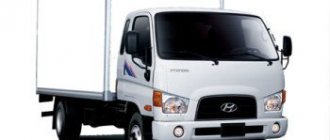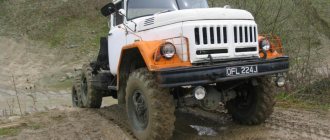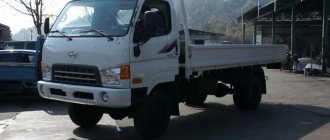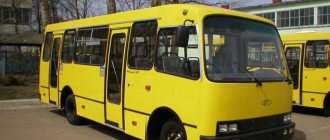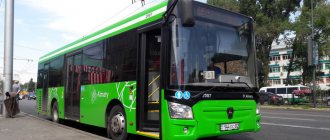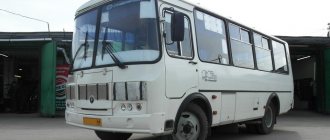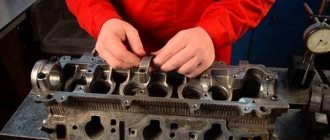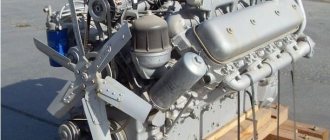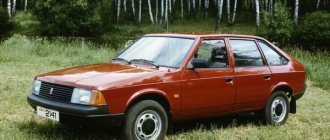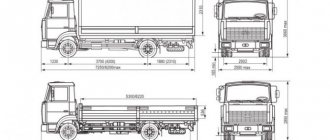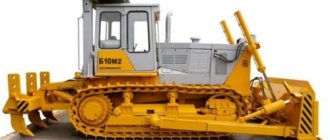Hyundai County Bus. Photo by Uni Motors
Hyundai County is a small class bus, ]Hyundai[/anchor], offered in two versions : Standard body (County SWB) and Long body (County LWB), depending on length and capacity. Began production in 1998. In 2004, an updated modification began to be produced - e-County.
Detailed description, device
The car has an all-metal carriage body , which does not have outstanding beauty. Large glass area, simple shapes and smooth corners - this is how the design of a Korean small-class bus can be generally characterized.
After the update, Hyundai County began to look much nicer. If the first models that replaced the Hyundai Chorus small bus looked exclusively Asian-style, then in the updated version the design will be of a more European type.
Large front optics with a simple shape are divided into three sections : internal - dimensions, central - main lighting and outer side - turn signals. Between the headlights there is a large false radiator grille in the form of a trapezoid, which is divided in half lengthwise by a chrome trim. Below is a neat bumper with rounded edges, which also has a small slot-like air intake, which goes on the sides into rectangular fog lights.
Also a distinctive feature can be considered the presence of a small air intake integrated into the vertically descending part of the roof above the County windshield. In both the first and second generations, the side rear view mirror is mounted not on the side of the bus, but on the front, and is moved to the side with a small bracket. Not far from the mirror mounting point are the windshield wiper mounting points.
In profile, the bus is completely boring, there are several stampings along the bottom, the doors are slightly recessed into the passenger compartment, which creates a convenient threshold.
Hyundai County Bus. Photo Wikipedia
The front fender of the Hyundai County exactly matches the front bumper and is, as it were, a continuation of it; the rear is slightly tucked in. The doors are fully glazed. There is additional glazing , below the window sill line, in the driver and front passenger seats.
At the rear, the design of the bus is no different, the same as at the front - a neat rear bumper , in the corners of which square fog lights . The rear optics have a similar shape. In the very center there is a space for a license plate, but the rest of the back is one solid sheet of metal with a small cutout in the upper part for rectangular glass.
The salon is equipped with comfortable and ergonomic passenger seats . The driver's seat is represented by a seat, which has its own air suspension and an optimal range of adjustments. Lumbar support is available as an option for the driver's seat . In front of the driver there is a 2-spoke steering wheel on a steering column that is adjustable in one plane.
Behind the wheel there is an informative dashboard , with two main “rounds” of the speedometer and tachometer and several small “rounds”. The dashboard and center console are separated by decorative wood . At the top of the Hyundai County center console there is a climate system control unit , and immediately below it are the audio system keys. On the right, air ducts are located in the form of a hemisphere. At the very bottom of the dashboard there is a row of buttons responsible for opening and closing the doors.
Design
The fuel, compressed to high pressure by the plunger, lifts the discharge valve and is expelled through it. At the end of the supply of fuel under pressure, the discharge valve lowers back to its original position under the action of a spring and closes the hole through which the fuel exits, preventing it from moving back. The discharge valve moves down until it is pressed firmly against the seat. During the return stroke of the valve, fuel is sucked from the high pressure fuel line, causing the residual pressure between the delivery valve and the injector to instantly drop. This phenomenon improves the process of completing fuel injection from the injector by preventing fuel from flowing after injection is completed.
Basic characteristics: dimensions and more
Hyundai County Bus. Photo by Uni Motors
Body dimensions, mm. Length / Width / Height of the standard version – 6345 / 2035 / 2630 and extended version – 7080 / 2035 / 2630.
Wheel track : front – 1705, rear – 1495.
Number and dimensions of doors. In any configuration, Hyundai County is equipped with two doors: one is standard in the middle, the second is emergency at the rear. But optionally, you can replace the rear door with a standard one, which will significantly speed up the process of loading and unloading passengers.
Passengers enter the bus through folding doors located on the right side of the body. For the driver there is a separate hinged door on the left side of the car.
Total number of seats, including landing seats. The standard version has 24 seats, the extended version has 19, 24, 26, 28 and 29 seats.
Type of seats. Inside the passenger compartment there are 1- and 2-seat seats for passengers. Along the rear wall there is an additional row of seats for 4 people. The seats are upholstered in soft material and equipped with inertial seat belts. But the design of the seats is not intended for traveling long distances. In general, the seats have optimal filling, acceptable dimensions and good ergonomics.
Hyundai County modifications
The Hyundai County bus is produced in 2 possible modifications: 7m (LWB) and 6m (SWB).
It belongs to the small class with a permissible capacity of 18 (+1) to 21 (+7) people. Hyundai hd County has excellent technical characteristics. It is easy to control, maneuverable, reliable and multifunctional. And the relatively low price of Hyundai County allows it to be the best-selling among similar models of equipment. Already as part of the basic configuration there is a good set of options, including: traction control and anti-lock braking systems, tachometer, power steering, mountain brake and fog lights. Heaters allow you to maintain warmth in the cabin during the winter season.
Specifications
Fuel type. Diesel.
Fuel tank capacity. 95 l.
Curb and technically permissible weight, kg. The curb weight is 3760 and 4180 for the standard and extended versions, respectively. Technically acceptable are 5223 and 6710.
Load on front/rear axle based on technically permissible weight, kg. 2141 and 3082 / 3220 and 3490.
Minimum turning radius, m. 6,2.
Steering gear. Hyundai, County steering is represented by a rack and pinion system with power steering.
Steering type. Screw-ball nut-rack-sector.
Brake system: service, parking, spare, auxiliary. Hydraulic dual-circuit drive with division into circuits along the axes, with amplifier, with ABS; brake mechanisms of all wheels - drum, each circuit of the service brake system, transmission brake mechanism with mechanical (cable) drive, engine brake-retarder.
Modifications... Fuel system
| Hyundai County | Bogdan A-069 since 1998, general information about the power system, instructions online But very quickly I realized that when changing lanes it is enough to see what the lenses are able to show, and the invisible tail will not go anywhere, since the head has passed. The bypass valve, located at the top of the pump, stabilizes the high pressure fuel pump's fuel temperature and temperature distribution, maintaining a constant amount of fuel injected into each cylinder. |
Engine and chassis • In principle, such seats should be more comfortable, but this is not the case.
Basic equipment
- Body painting. Basic colors – blue, white. To order when choosing from a color catalog.
- Doors. Two doors, tilting type, electrically controlled, are equipped with emergency buttons for passengers to exit.
- Window. Single glued.
- Seats for passengers. Separate, high back, fabric upholstery.
- Driver's seat. On air suspension.
- Seat belts. Installed on the driver's seat and on all passenger seats.
- Audio preparation. Speakerphone, CD radio, speakers.
- Equipment: roller blind;
- window tinting;
- fog lights;
- wood panel finish;
- wheel covers;
- jack, spare tire, tool kit (tire inflation hose, first aid kit, full set of keys, car lamp, fire extinguishers, etc.)
Lifetime of buses and their individual components during operation in Russia
Before talking about the service life of parts, we need to make an important note: different models and modifications of Hyundai County buses, produced at different times in South Korea and Russia, have different degrees of reliability and service life. That is why some Country owners speak with delight about their buses, while others express only dissatisfaction. Here we will talk only about the most common faults inherent in this bus, and also provide average data on the service life of its individual components and assemblies.
Power point. Hyundai County engines have fairly high reliability, so they are the least likely to cause complaints from bus owners. Problems most often arise with an extended service interval, but if you follow the manufacturer’s recommendations and change the engine oil every 15-20 thousand kilometers (and when operating in difficult conditions, the oil can be changed more often - every 7.5 or even 5 thousand kilometers ), the motor will serve reliably for many years.
Transmission. The gearbox, crankshaft and drive axle are some of the most reliable components on a bus. The manufacturer recommends changing the gearbox oil every 40 thousand km, and the axle oil every 60 thousand km. According to reviews from owners, the transmission most rarely needs repairs, although due to the poor quality of roads, these parts also have to be repaired and replaced periodically. Certain problems sometimes arise with the clutch, in particular, due to loads, the clutch fork is deformed; the likelihood of this breakdown can be reduced by lubricating this part (through a window specially provided for this) approximately every 5 thousand km. And often, County owners are faced with a break and other damage to the gearshift cable, so it’s worth having one or two such cables in stock, which can be quickly replaced without the bus downtime.
Chassis. It is the chassis that most often becomes the source of problems, although there is nothing surprising here. “Native” springs (Korean or Chinese production) sometimes last only 35-40 thousand km. Anti-roll bars also have a short lifespan; their end bushings break after just one or two thousand kilometers (and sometimes earlier). This problem is usually solved by handicraft by inserting improvised silent blocks from a piece of rubber. And the entire chassis quickly “looses”, play in the joints of parts increases, vibration and beating occur - these problems have to be solved by frequent adjustments, as well as by replacing silent blocks, bushings and other parts.
Body. The quality of the body and interior decoration of the bus promises to be much better, and if you do not take into account technical problems, then it is the body that most often becomes the cause of headaches for County owners. The fact is that already in the first months of operation, various interior seals lose their reliability, unacceptable gaps appear in many places, and the appearance of the trim parts quickly deteriorates. The paintwork of the body causes certain problems - after only one and a half to two years of operation, its quality deteriorates, in places the metal is exposed, which becomes the cause of intense corrosion.
Other details. Other features worth noting are the extremely low service life of the aluminum pipelines of the built-in air conditioner, the limited service life of the pneumatic system pipelines for three to five years, the rapid clogging of the radiator of the engine cooling system, and the frequent failure of the heater radiator. These problems can be solved by timely replacement of parts, and it is also necessary to periodically inspect and clean radiators and other parts.
Features/Benefits
- Economical. County is the most economical, due to minimal fuel consumption and a diesel engine. Car maintenance does not require extra investment. If operating standards and rules are strictly followed, the County bus will serve for a long time without breakdowns.
- Harmonious design. The County bus has a modern design. Everything is done as functionally and harmoniously as possible, which makes it stand out from the general flow of vehicles.
- Comfort. County is designed to provide the greatest comfort for both driver and passengers. Comfortable chairs with special backs do not cause a feeling of fatigue even when traveling for many hours. Hyundai County can be used as: excursion transport, official transport, city taxi.
- The chassis can withstand poor quality roads very well. The special suspension design copes well with any uneven road surface, the passage over which is practically not felt in the cabin.
- The bus is equipped with anti-roll bars , which dampen excessive body sway and help improve handling and directional stability.
Malfunctions
During its service, the bus has established itself as one of the most reliable, so it is extremely difficult to find flaws in it. However, there are cases when the limit switches begin to act up, in particular on the clutch pedal, which leads to problems with the exhaust brake.
Also, the most common problem is spring breakage. This problem is solved by strengthening the suspension. As for the engine and gearbox, problems here bypass all owners and the bus is absolutely not picky about fuel quality.
Where to buy equipment and spare parts: fuse box and more
Few companies sell Hyundai County buses, some are presented on our website. Sellers also sell spare parts and components. In addition, clients have the opportunity to rent and lease vehicles. If necessary, employees of companies specializing in the conversion of passenger transport have the opportunity to make a variety of changes to the design and design. It is also possible to purchase the model on the secondary market. On the Internet you can find a large number of advertisements for the sale of used buses with mileage.
Price
Assembly in Russia has already been stopped. The same as supplies from Korea. But there are still copies without mileage, for which you will have to pay at least 1,700,000 rubles. Supported, but fresh options on the secondary market are sold for 600,000-800,000 rubles.
The bus, despite the cessation of supplies, is in high demand on the secondary market, and copies that have long celebrated their tenth anniversary are still traveling on city routes. This speaks of the true Korean reliability of the model and the high service life of both the engine itself and other technical components of Hyundai County - a real workhorse.
Certificate of maturity
Hyundai County turned out to be not just another exhibition project, but a completely functional unit, ready to occupy its niche among school buses. In the city, it can be safely used in private schools that practice centralized delivery of students. At least yards filled with cars won’t be a problem for it - even though its length is a little more than 7 m, and its wheelbase is only 4. As for country trips, it’s harder to say, I haven’t driven it myself, but judging by the high ground clearance of 350 mm, the lack parts protruding under the bottom and a small overhang, there will be no problems with the collection of children in rural schools either. Nineteen full-fledged chairs allow, if necessary, to comfortably transport not only children, but also their parents to a cultural event in a district or regional center. And we shouldn’t forget that the County is not a hybrid of a cargo chassis and a passenger body, or even a “vanbus,” but a small one, but still a bus.
Provided a bus for testing
Vasya
TagAZ Hyundai County buses are equipped with a 107-horsepower diesel engine with a volume of 3.9 liters.
The fuel consumption of the model in the combined cycle is 18 l/100 km. The TagAZ Hyundai County is based on a rigid frame, which significantly increases the strength of the entire bus. One of the main advantages of TagAZ Hyundai County is that these buses are not overloaded with various electronics. This makes it cheaper and easier to operate. This is a Korean small-class bus, adapted for urban and suburban passenger transportation. The model was produced until 2014; many modifications of it can still be found on sale.
Under the hood, such a vehicle can have six different powertrain options. In Russia, a model was sold with a D4DD turbodiesel with four cylinders capable of producing up to 144 horsepower.
The salon is comfortable and roomy. Seats with high backs are located in one row on the side of the entrance door and in two rows on the window side. There is no separate luggage compartment; bags can be left in the aisle.
